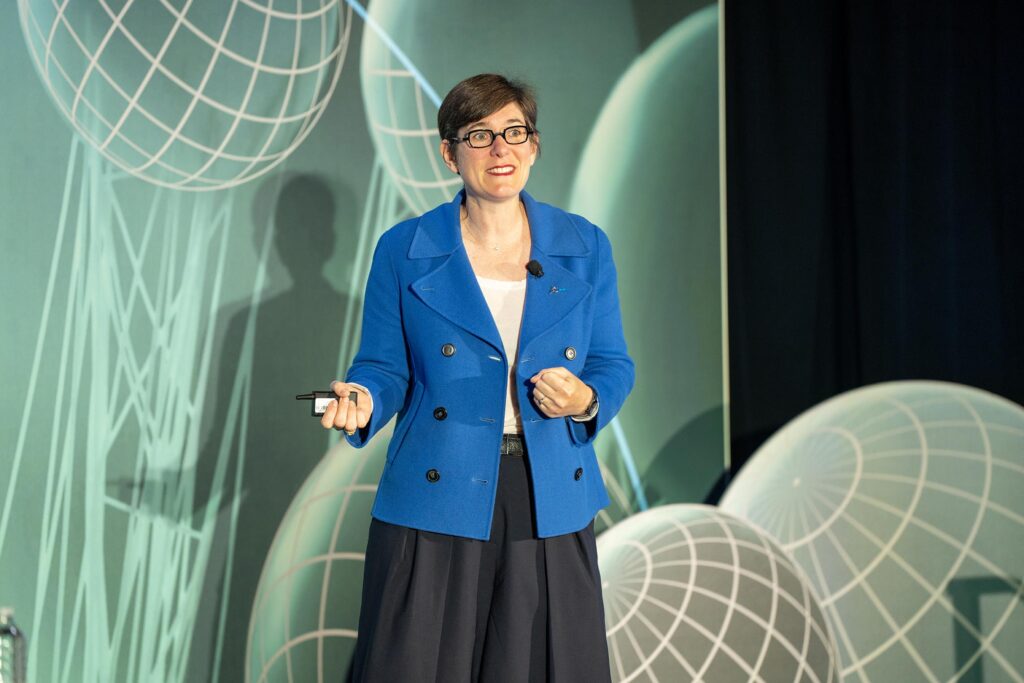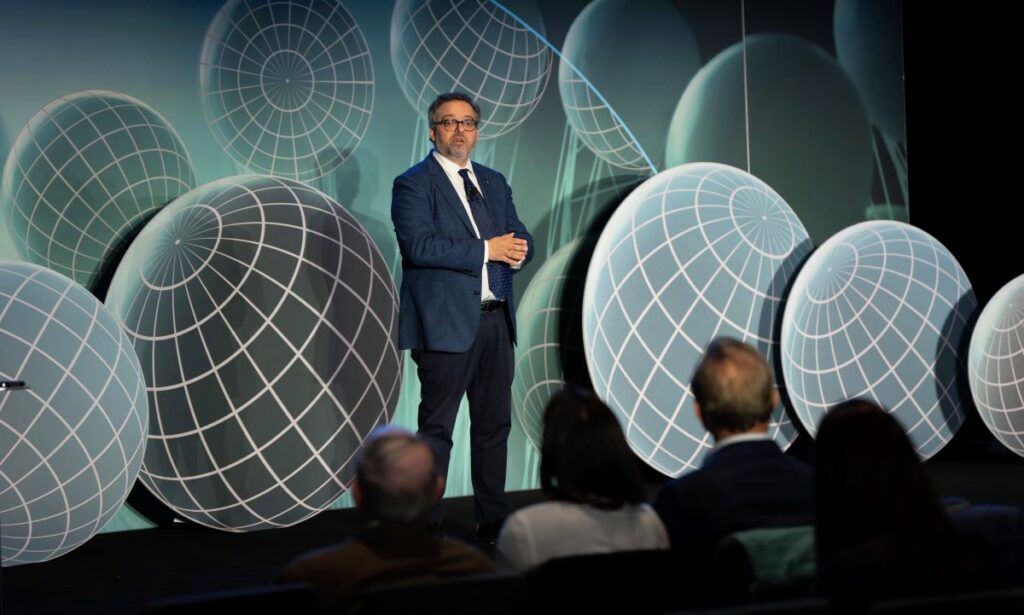This is big. Imagine yourself 20 years from now. What do you see? Sure, you’re a little older, maybe a little grayer; but are you happier, healthier?
With this vision of future health, you will be.
Picture this: You have a personalized diet and wellness routine, tuned exactly to what your body needs to give you plenty of energy to keep you active, and wind down smoothly so you sleep deeply through the night. Effortlessly, you track your personal health data so you know what’s working and are alerted if anything starts to look off. Empowered with your virtual twin, your doctors are part of your wellness team; they’re health coaches aiding in your decisions as your twin is regularly updated by the biometric trackers you wear or use at home. When you do need a procedure, you’re all confident it will work, because you’ve already seen it work on you … the virtual you.
You’re seeing our vision for the future of life sciences and healthcare. A future where patients become consumers, in control of their healthcare and an industry where virtual twin experiences are the catalyst for sustainable innovation and efficient healthcare systems.
“Imagine if you’re able to understand, represent, test and predict what can’t be seen – from the way a drug affects a disease to the outcome of a surgical intervention,” Claire Biot, our VP of Life Sciences and Healthcare, said introducing Dassault Systèmes’ vision for the industry earlier this year. “That’s really what we are striving to achieve and we want to position the virtual twin as way to propose a platform for medical practice excellence and value-based care.”
A foundation to shape the future of healthcare
Biot was speaking at the Dassault Systèmes Virtual Human Twin Experience Symposium, a conference convening innovators and practitioners across the entire healthcare lifecycle together in Boston and virtually around the world. In her keynote address, she explained that, for the past 10 years, Dassault Systèmes has been investing massively in virtual twin experiences for healthcare because we believe it is the time to make our systems more equitable and sustainable.
“We think it is time to change now,” Biot said. “If you look at the world, only half of the worldwide population has access to essential healthcare today. If you now focus on developed countries, the healthy life expectancy has not progressed much in the past few years, despite the fact that healthcare expenses have grown twice as fast as GDP. We think it’s not sustainable. We want to help meet medical needs with sustainable healthcare systems. To do so, our belief is that virtual twin experiences are really the game changer.”

Across Dassault Systèmes’ 13,000 life sciences and healthcare customers around the world, there is clear evidence this investment is paying off, accelerating innovation in life sciences and healthcare.
More than half of the drugs and medical devices that have come to market in recent years were designed using our solutions and nearly half of new commercial clinical trials are supported by the Medidata platform.
Most critically, when they were put to the test, during the COVID-19 pandemic, vaccines were developed in record time.
“Today, our footprint gives us a cross-domain advantage to shaping the future,” said Biot. To leverage this ecosystem, the virtual twin strategy is the most effective way to capture that experience into a usable form. For example, virtual twins of radiology treatments allow patients to virtually experience their treatment in advance, so the real thing will go smoothly. Using virtual twins of hospitals for safer working conditions by simulating airflow minimizes the spread of airborne contaminants. And, in possibly the most innovate technology breakthrough and the centerpiece of the symposium, the Living Heart and Living Brain projects, introduced earlier by Patrick Johnson, SVP of Research and Sciences, in his keynote, are advancing development of cardiovascular and neurological products and treatments through the use of virtual twins of human organs.
Explaining Dassault Systèmes’ investment in healthcare
Transforming the massive healthcare industry is an ambitious vision, but drawing on decades of experience, Dassault Systèmes has a plan, as explained by Biot.
Historically, we have focused on the innovation side of the healthcare system: biopharma, medical device and medical equipment companies. As such, our offerings today are focused around the interests of those segments, including molecular therapies, digital therapies and med devices up to and including the regulatory process. But to achieve our vision for the future of healthcare, we have the ambition to expand to the broader healthcare system, including healthcare providers, service centers and payer communities as these have become digitally enabled.
The plan is founded on investments into three new kinds of virtual twin experiences in healthcare:
- Patient: to use real patient data to create virtual patient models that help understand diseases, simulate different treatment options and optimize outcomes
- Hospitals: to understand the context in which care is given and optimize settings for medical professionals
- Healthcare system: to understand money flow and incentives, and support affordable and accessible healthcare
Building off proof points such as the Biointelligence and Living Heart Projects, VORTHEx and many others, a key to realizing this ambition is our commitment to developing virtual twins of humans. A goal far beyond the ambitious Human Genome Project, the virtual twin of a human body involves understanding, in detail how to model and represent the body, our organs and all of the interconnections that make us human.
“To us, virtual twins of humans are an engagement framework,” said Johnson during the Science Week events earlier this year. “We are considering ourselves as a catalyst.”

Johnson explained virtual twins of humans will be a reference for the future of healthcare. Virtual worlds provide a new way of looking at things, multiple disciplines to come together, combine expertise and determine how to act. Virtual experiences in healthcare will lead to better care for patients, faster development of biologics and devices, more efficient operations at hospitals and modular pharmaceutical factories.
“We are launching worldwide a massive program to address many medical use cases and many medical challenges in order to deliver this healthcare platform,” Johnson said. “We also want to propose an open compendium for medical twins, medical organs, medical practices being simulated or experiencable, because we believe adoption, education, dissemination will be key transformation factors to have a smooth, progressive transition from the state of medical art today to twin-based, next generation medical art.”
Value-based care with value for all
So that’s the vision: value for innovators, for practitioners and a long healthy life for us. It won’t happen overnight and certainly we can’t do it alone. But we hope our vision can serve as a call to action and that our solutions can be a catalyst for collaboration and advancement toward the goal of a better, more equitable and more sustainable healthcare system.
Picture this: Powerful AI tools can design a virtual twin of a molecule custom fit to a virtual twin of your DNA, your cell or damaged organ and we’re talking about personalized generative therapeutic design safely delivering more precise medicine when you need it. Or synthetic patients in a clinical trial, using control arms constructed from historical data to eliminate placebo groups or even virtual twins in the treatment group to achieve greater diversity. Slicing the cost barriers to innovation, even cures for rare diseases become possible. To meet global demands, virtual twins of manufacturing processes work with BIOVIA tools for process and drug development allows scale up production of new biologics for precision medicine in any geographic environment. Consumers, armed with real, personal, dynamic medical data they understand is the first step toward a new paradigm that nurtures wellness over a lifetime.
“Just imagine… if you’re able to understand, represent, test and predict what can’t be seen – from the way a drug affects a disease to the outcome of a surgical intervention,” Biot said at the conference. “That’s really what we are trying to achieve and we want to position the virtual twin as way to propose a platform for medical practice excellence and value-based care.”
With that vision for the future of healthcare in mind, here are eight elements of what Dassault Systèmes VP of Life Sciences and Healthcare Claire Biot believes “healthy” will look like in 2040.
- Personalized food for health and wellness will help folks maintain health as much as possible
- Continuous monitoring of personal medical data will help us monitor if we’re remaining healthy and can detect disease as early as possible to trigger timely action.
- Patients becoming actors in their own health thanks to personalized medical data and two-way communication with healthcare professionals
- Relationships change and evolve to where doctors become more like coaches or mentors to informed patients who are directly involved in decision making
- Siloed patient journeys become continuous health journeys with virtual twins becoming a next gen healthcare reference and leading to better, more cohesive understanding of patient health data.
- Next gen precision therapies advance and evolve thanks to advancing virtual twin experiences and AI.
- Treatment interventions are all tested on virtual twins before patients leading to safer, more effective interventions in the real world.
- Health coverage for all.
Watch sessions from the Virtual Human Twin Experience Symposium now available on-demand.

